Strategic Development of Organisations: Leadership and Retention
VerifiedAdded on 2020/06/03
|10
|3083
|48
Report
AI Summary
This report provides a detailed analysis of leadership and employee retention strategies within organizations, particularly in the context of uncertainty. It begins with an introduction that outlines the study's overview, background, and objectives, focusing on the challenges faced by 4com Plc. The literature review explores key concepts such as leadership styles, employee retention factors, the role of culture, and the development of relationships both within and outside the organization. The report examines the impact of uncertainty on employee relations and the importance of effective leadership in navigating these challenges. It discusses frameworks for understanding uncertainty, including clear future, alternative future aims, a wide range of future, and true ambiguity. The report emphasizes the importance of leadership skills, employee empowerment, and performance management. It also highlights the significance of developing a signature leadership style and building a collaborative work environment. The conclusion summarizes the findings and offers recommendations for improving leadership and employee retention within 4com Plc. The report aims to provide insights into how organizations can strategically develop leadership and maintain employee engagement in uncertain environments, focusing on the interplay of leadership, organizational culture, and employee relations.
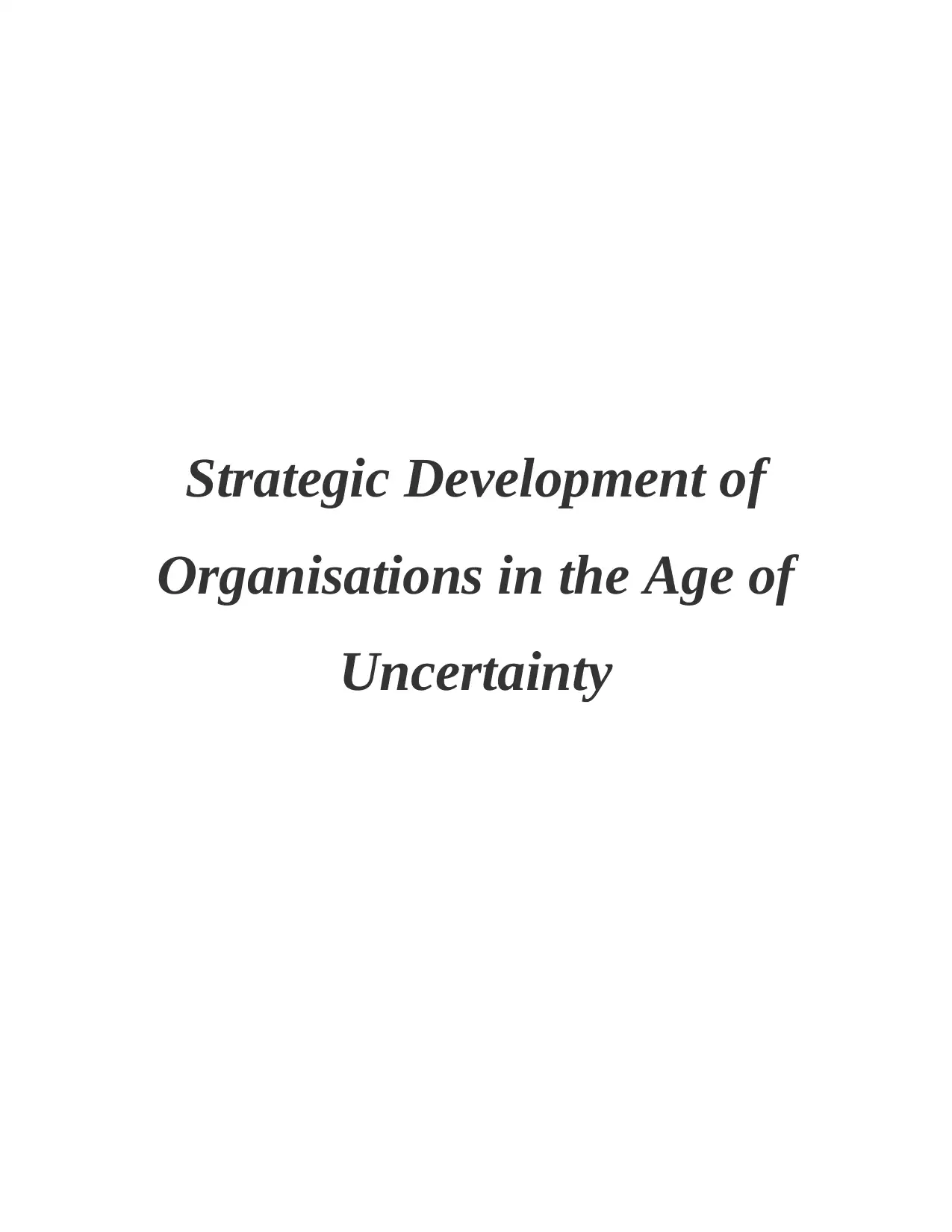
Strategic Development of
Organisations in the Age of
Uncertainty
Organisations in the Age of
Uncertainty
Paraphrase This Document
Need a fresh take? Get an instant paraphrase of this document with our AI Paraphraser
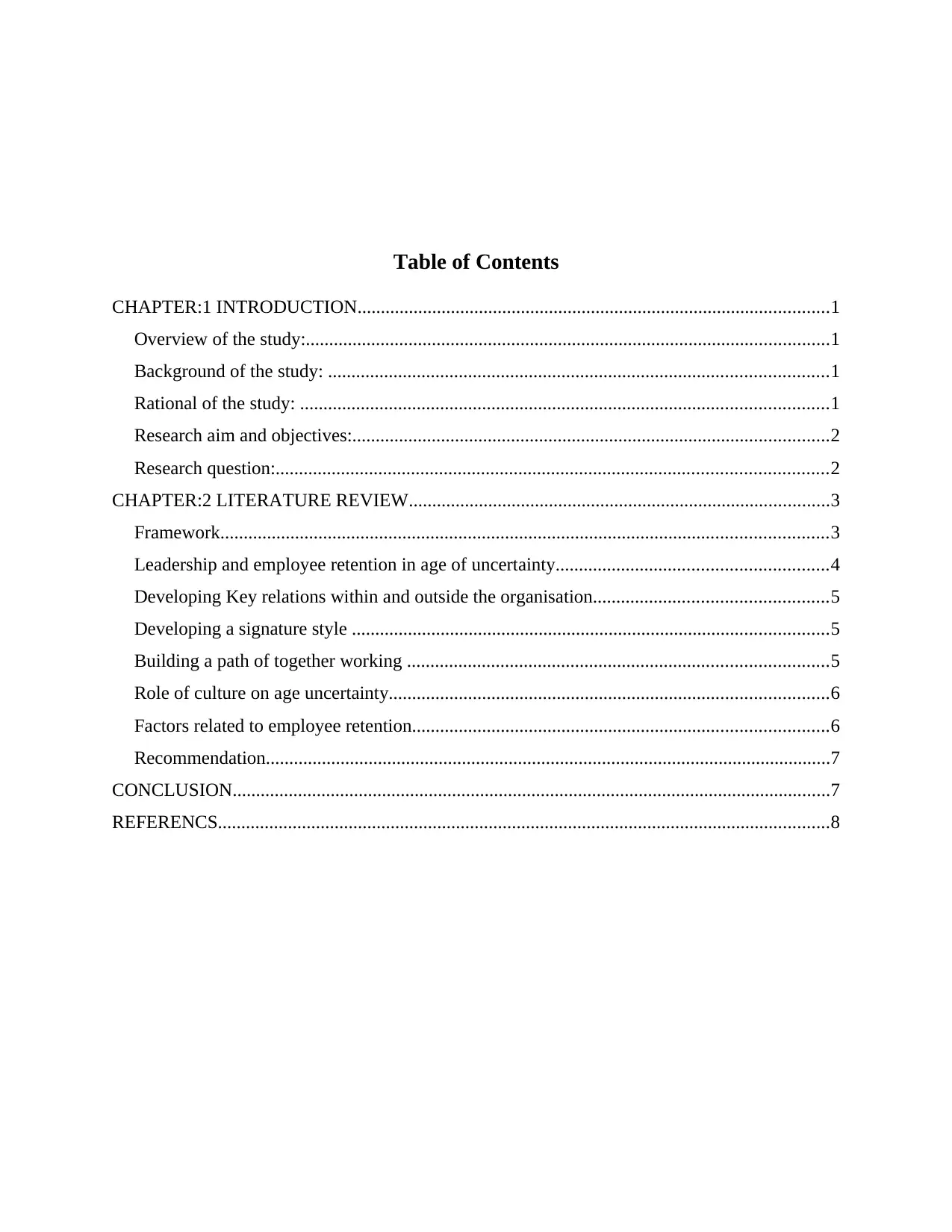
Table of Contents
CHAPTER:1 INTRODUCTION.....................................................................................................1
Overview of the study:................................................................................................................1
Background of the study: ...........................................................................................................1
Rational of the study: .................................................................................................................1
Research aim and objectives:......................................................................................................2
Research question:......................................................................................................................2
CHAPTER:2 LITERATURE REVIEW..........................................................................................3
Framework..................................................................................................................................3
Leadership and employee retention in age of uncertainty..........................................................4
Developing Key relations within and outside the organisation..................................................5
Developing a signature style ......................................................................................................5
Building a path of together working ..........................................................................................5
Role of culture on age uncertainty..............................................................................................6
Factors related to employee retention.........................................................................................6
Recommendation.........................................................................................................................7
CONCLUSION................................................................................................................................7
REFERENCS...................................................................................................................................8
CHAPTER:1 INTRODUCTION.....................................................................................................1
Overview of the study:................................................................................................................1
Background of the study: ...........................................................................................................1
Rational of the study: .................................................................................................................1
Research aim and objectives:......................................................................................................2
Research question:......................................................................................................................2
CHAPTER:2 LITERATURE REVIEW..........................................................................................3
Framework..................................................................................................................................3
Leadership and employee retention in age of uncertainty..........................................................4
Developing Key relations within and outside the organisation..................................................5
Developing a signature style ......................................................................................................5
Building a path of together working ..........................................................................................5
Role of culture on age uncertainty..............................................................................................6
Factors related to employee retention.........................................................................................6
Recommendation.........................................................................................................................7
CONCLUSION................................................................................................................................7
REFERENCS...................................................................................................................................8
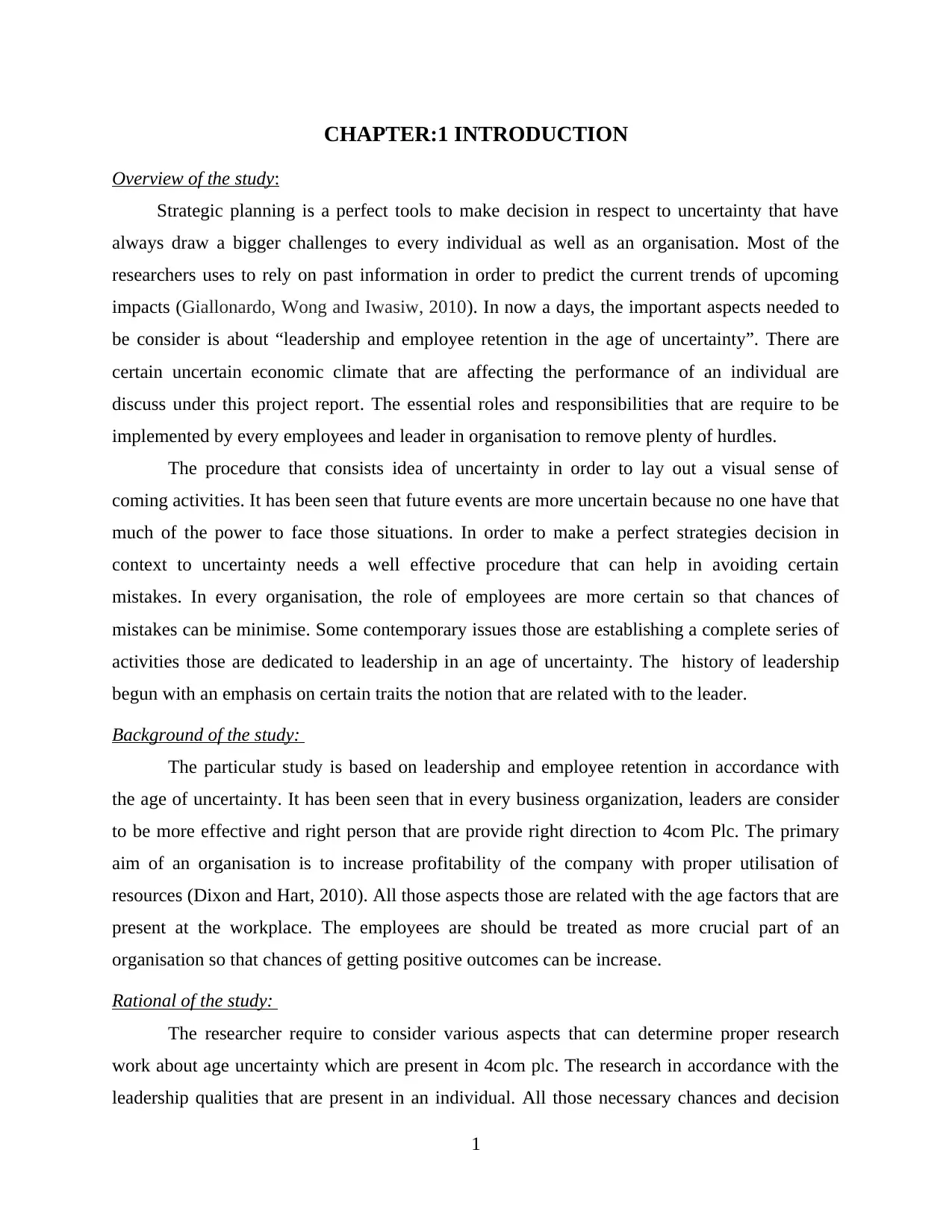
CHAPTER:1 INTRODUCTION
Overview of the study:
Strategic planning is a perfect tools to make decision in respect to uncertainty that have
always draw a bigger challenges to every individual as well as an organisation. Most of the
researchers uses to rely on past information in order to predict the current trends of upcoming
impacts (Giallonardo, Wong and Iwasiw, 2010). In now a days, the important aspects needed to
be consider is about “leadership and employee retention in the age of uncertainty”. There are
certain uncertain economic climate that are affecting the performance of an individual are
discuss under this project report. The essential roles and responsibilities that are require to be
implemented by every employees and leader in organisation to remove plenty of hurdles.
The procedure that consists idea of uncertainty in order to lay out a visual sense of
coming activities. It has been seen that future events are more uncertain because no one have that
much of the power to face those situations. In order to make a perfect strategies decision in
context to uncertainty needs a well effective procedure that can help in avoiding certain
mistakes. In every organisation, the role of employees are more certain so that chances of
mistakes can be minimise. Some contemporary issues those are establishing a complete series of
activities those are dedicated to leadership in an age of uncertainty. The history of leadership
begun with an emphasis on certain traits the notion that are related with to the leader.
Background of the study:
The particular study is based on leadership and employee retention in accordance with
the age of uncertainty. It has been seen that in every business organization, leaders are consider
to be more effective and right person that are provide right direction to 4com Plc. The primary
aim of an organisation is to increase profitability of the company with proper utilisation of
resources (Dixon and Hart, 2010). All those aspects those are related with the age factors that are
present at the workplace. The employees are should be treated as more crucial part of an
organisation so that chances of getting positive outcomes can be increase.
Rational of the study:
The researcher require to consider various aspects that can determine proper research
work about age uncertainty which are present in 4com plc. The research in accordance with the
leadership qualities that are present in an individual. All those necessary chances and decision
1
Overview of the study:
Strategic planning is a perfect tools to make decision in respect to uncertainty that have
always draw a bigger challenges to every individual as well as an organisation. Most of the
researchers uses to rely on past information in order to predict the current trends of upcoming
impacts (Giallonardo, Wong and Iwasiw, 2010). In now a days, the important aspects needed to
be consider is about “leadership and employee retention in the age of uncertainty”. There are
certain uncertain economic climate that are affecting the performance of an individual are
discuss under this project report. The essential roles and responsibilities that are require to be
implemented by every employees and leader in organisation to remove plenty of hurdles.
The procedure that consists idea of uncertainty in order to lay out a visual sense of
coming activities. It has been seen that future events are more uncertain because no one have that
much of the power to face those situations. In order to make a perfect strategies decision in
context to uncertainty needs a well effective procedure that can help in avoiding certain
mistakes. In every organisation, the role of employees are more certain so that chances of
mistakes can be minimise. Some contemporary issues those are establishing a complete series of
activities those are dedicated to leadership in an age of uncertainty. The history of leadership
begun with an emphasis on certain traits the notion that are related with to the leader.
Background of the study:
The particular study is based on leadership and employee retention in accordance with
the age of uncertainty. It has been seen that in every business organization, leaders are consider
to be more effective and right person that are provide right direction to 4com Plc. The primary
aim of an organisation is to increase profitability of the company with proper utilisation of
resources (Dixon and Hart, 2010). All those aspects those are related with the age factors that are
present at the workplace. The employees are should be treated as more crucial part of an
organisation so that chances of getting positive outcomes can be increase.
Rational of the study:
The researcher require to consider various aspects that can determine proper research
work about age uncertainty which are present in 4com plc. The research in accordance with the
leadership qualities that are present in an individual. All those necessary chances and decision
1
⊘ This is a preview!⊘
Do you want full access?
Subscribe today to unlock all pages.

Trusted by 1+ million students worldwide
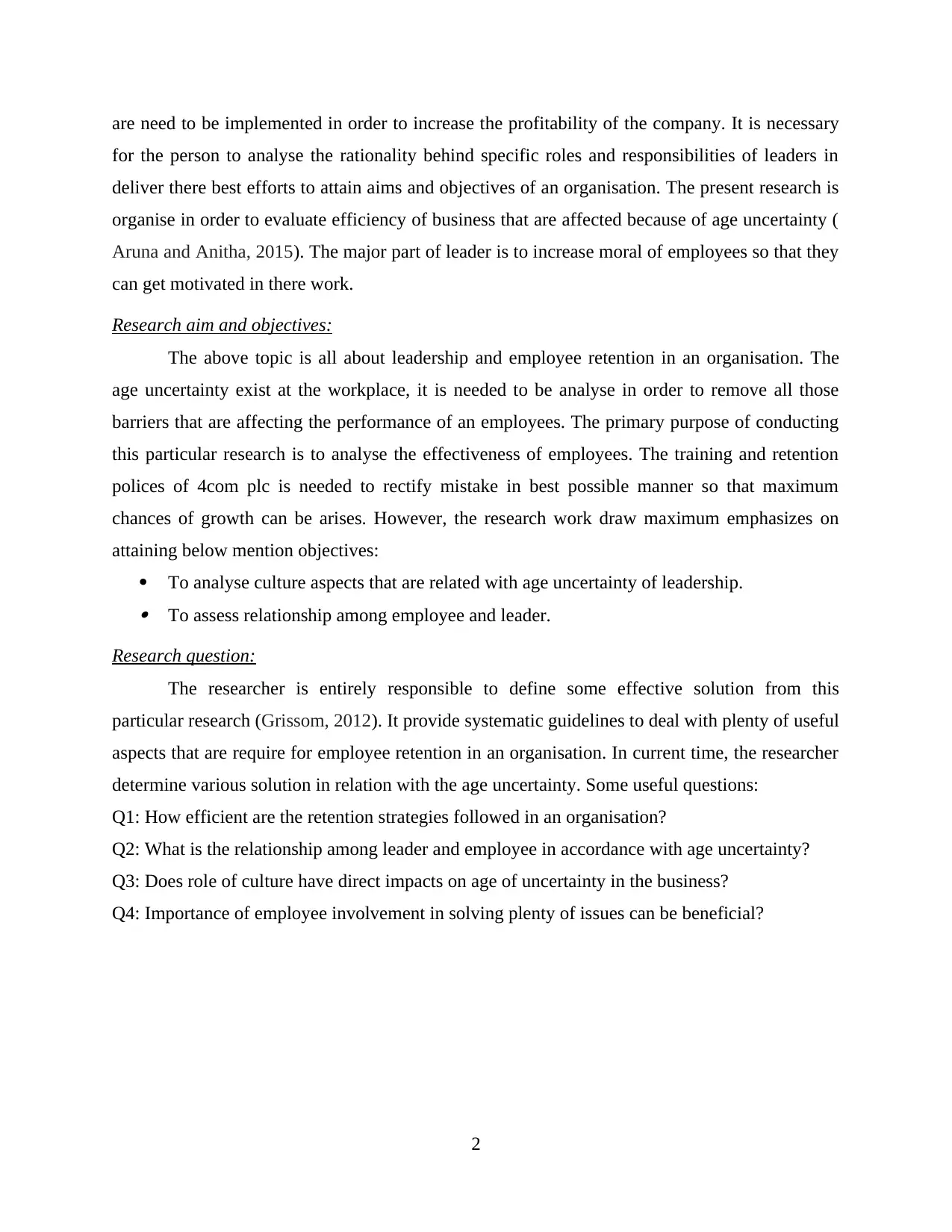
are need to be implemented in order to increase the profitability of the company. It is necessary
for the person to analyse the rationality behind specific roles and responsibilities of leaders in
deliver there best efforts to attain aims and objectives of an organisation. The present research is
organise in order to evaluate efficiency of business that are affected because of age uncertainty (
Aruna and Anitha, 2015). The major part of leader is to increase moral of employees so that they
can get motivated in there work.
Research aim and objectives:
The above topic is all about leadership and employee retention in an organisation. The
age uncertainty exist at the workplace, it is needed to be analyse in order to remove all those
barriers that are affecting the performance of an employees. The primary purpose of conducting
this particular research is to analyse the effectiveness of employees. The training and retention
polices of 4com plc is needed to rectify mistake in best possible manner so that maximum
chances of growth can be arises. However, the research work draw maximum emphasizes on
attaining below mention objectives:
To analyse culture aspects that are related with age uncertainty of leadership. To assess relationship among employee and leader.
Research question:
The researcher is entirely responsible to define some effective solution from this
particular research (Grissom, 2012). It provide systematic guidelines to deal with plenty of useful
aspects that are require for employee retention in an organisation. In current time, the researcher
determine various solution in relation with the age uncertainty. Some useful questions:
Q1: How efficient are the retention strategies followed in an organisation?
Q2: What is the relationship among leader and employee in accordance with age uncertainty?
Q3: Does role of culture have direct impacts on age of uncertainty in the business?
Q4: Importance of employee involvement in solving plenty of issues can be beneficial?
2
for the person to analyse the rationality behind specific roles and responsibilities of leaders in
deliver there best efforts to attain aims and objectives of an organisation. The present research is
organise in order to evaluate efficiency of business that are affected because of age uncertainty (
Aruna and Anitha, 2015). The major part of leader is to increase moral of employees so that they
can get motivated in there work.
Research aim and objectives:
The above topic is all about leadership and employee retention in an organisation. The
age uncertainty exist at the workplace, it is needed to be analyse in order to remove all those
barriers that are affecting the performance of an employees. The primary purpose of conducting
this particular research is to analyse the effectiveness of employees. The training and retention
polices of 4com plc is needed to rectify mistake in best possible manner so that maximum
chances of growth can be arises. However, the research work draw maximum emphasizes on
attaining below mention objectives:
To analyse culture aspects that are related with age uncertainty of leadership. To assess relationship among employee and leader.
Research question:
The researcher is entirely responsible to define some effective solution from this
particular research (Grissom, 2012). It provide systematic guidelines to deal with plenty of useful
aspects that are require for employee retention in an organisation. In current time, the researcher
determine various solution in relation with the age uncertainty. Some useful questions:
Q1: How efficient are the retention strategies followed in an organisation?
Q2: What is the relationship among leader and employee in accordance with age uncertainty?
Q3: Does role of culture have direct impacts on age of uncertainty in the business?
Q4: Importance of employee involvement in solving plenty of issues can be beneficial?
2
Paraphrase This Document
Need a fresh take? Get an instant paraphrase of this document with our AI Paraphraser
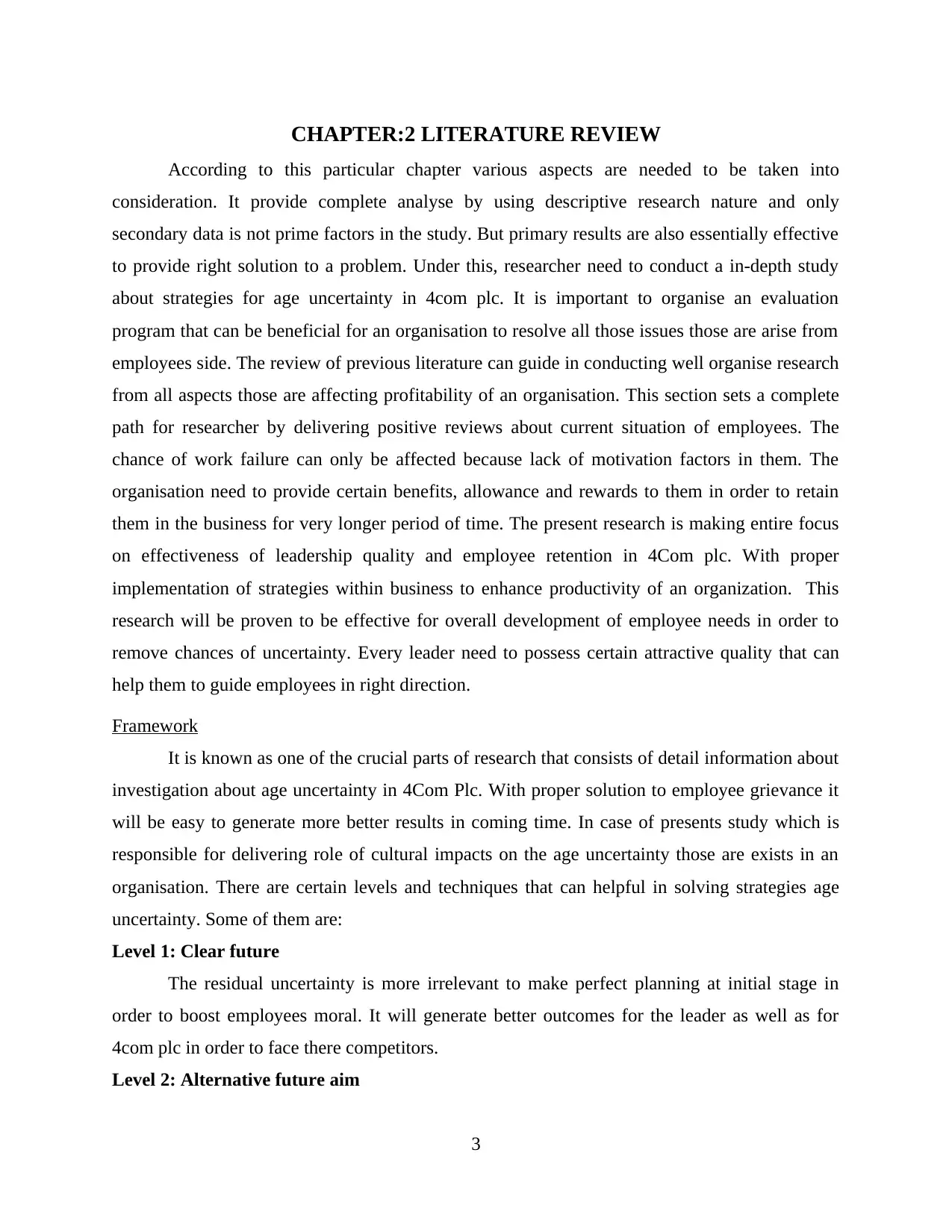
CHAPTER:2 LITERATURE REVIEW
According to this particular chapter various aspects are needed to be taken into
consideration. It provide complete analyse by using descriptive research nature and only
secondary data is not prime factors in the study. But primary results are also essentially effective
to provide right solution to a problem. Under this, researcher need to conduct a in-depth study
about strategies for age uncertainty in 4com plc. It is important to organise an evaluation
program that can be beneficial for an organisation to resolve all those issues those are arise from
employees side. The review of previous literature can guide in conducting well organise research
from all aspects those are affecting profitability of an organisation. This section sets a complete
path for researcher by delivering positive reviews about current situation of employees. The
chance of work failure can only be affected because lack of motivation factors in them. The
organisation need to provide certain benefits, allowance and rewards to them in order to retain
them in the business for very longer period of time. The present research is making entire focus
on effectiveness of leadership quality and employee retention in 4Com plc. With proper
implementation of strategies within business to enhance productivity of an organization. This
research will be proven to be effective for overall development of employee needs in order to
remove chances of uncertainty. Every leader need to possess certain attractive quality that can
help them to guide employees in right direction.
Framework
It is known as one of the crucial parts of research that consists of detail information about
investigation about age uncertainty in 4Com Plc. With proper solution to employee grievance it
will be easy to generate more better results in coming time. In case of presents study which is
responsible for delivering role of cultural impacts on the age uncertainty those are exists in an
organisation. There are certain levels and techniques that can helpful in solving strategies age
uncertainty. Some of them are:
Level 1: Clear future
The residual uncertainty is more irrelevant to make perfect planning at initial stage in
order to boost employees moral. It will generate better outcomes for the leader as well as for
4com plc in order to face there competitors.
Level 2: Alternative future aim
3
According to this particular chapter various aspects are needed to be taken into
consideration. It provide complete analyse by using descriptive research nature and only
secondary data is not prime factors in the study. But primary results are also essentially effective
to provide right solution to a problem. Under this, researcher need to conduct a in-depth study
about strategies for age uncertainty in 4com plc. It is important to organise an evaluation
program that can be beneficial for an organisation to resolve all those issues those are arise from
employees side. The review of previous literature can guide in conducting well organise research
from all aspects those are affecting profitability of an organisation. This section sets a complete
path for researcher by delivering positive reviews about current situation of employees. The
chance of work failure can only be affected because lack of motivation factors in them. The
organisation need to provide certain benefits, allowance and rewards to them in order to retain
them in the business for very longer period of time. The present research is making entire focus
on effectiveness of leadership quality and employee retention in 4Com plc. With proper
implementation of strategies within business to enhance productivity of an organization. This
research will be proven to be effective for overall development of employee needs in order to
remove chances of uncertainty. Every leader need to possess certain attractive quality that can
help them to guide employees in right direction.
Framework
It is known as one of the crucial parts of research that consists of detail information about
investigation about age uncertainty in 4Com Plc. With proper solution to employee grievance it
will be easy to generate more better results in coming time. In case of presents study which is
responsible for delivering role of cultural impacts on the age uncertainty those are exists in an
organisation. There are certain levels and techniques that can helpful in solving strategies age
uncertainty. Some of them are:
Level 1: Clear future
The residual uncertainty is more irrelevant to make perfect planning at initial stage in
order to boost employees moral. It will generate better outcomes for the leader as well as for
4com plc in order to face there competitors.
Level 2: Alternative future aim
3
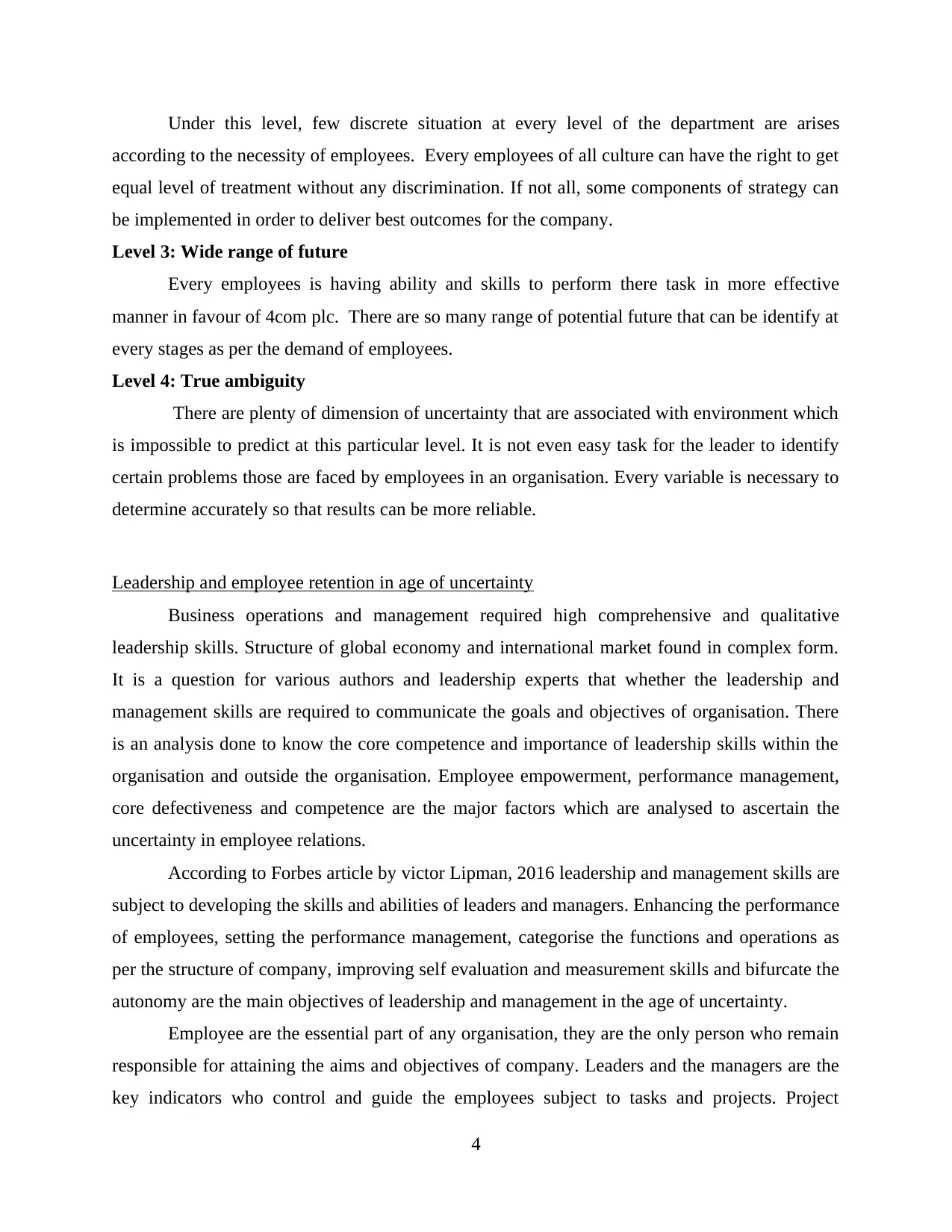
Under this level, few discrete situation at every level of the department are arises
according to the necessity of employees. Every employees of all culture can have the right to get
equal level of treatment without any discrimination. If not all, some components of strategy can
be implemented in order to deliver best outcomes for the company.
Level 3: Wide range of future
Every employees is having ability and skills to perform there task in more effective
manner in favour of 4com plc. There are so many range of potential future that can be identify at
every stages as per the demand of employees.
Level 4: True ambiguity
There are plenty of dimension of uncertainty that are associated with environment which
is impossible to predict at this particular level. It is not even easy task for the leader to identify
certain problems those are faced by employees in an organisation. Every variable is necessary to
determine accurately so that results can be more reliable.
Leadership and employee retention in age of uncertainty
Business operations and management required high comprehensive and qualitative
leadership skills. Structure of global economy and international market found in complex form.
It is a question for various authors and leadership experts that whether the leadership and
management skills are required to communicate the goals and objectives of organisation. There
is an analysis done to know the core competence and importance of leadership skills within the
organisation and outside the organisation. Employee empowerment, performance management,
core defectiveness and competence are the major factors which are analysed to ascertain the
uncertainty in employee relations.
According to Forbes article by victor Lipman, 2016 leadership and management skills are
subject to developing the skills and abilities of leaders and managers. Enhancing the performance
of employees, setting the performance management, categorise the functions and operations as
per the structure of company, improving self evaluation and measurement skills and bifurcate the
autonomy are the main objectives of leadership and management in the age of uncertainty.
Employee are the essential part of any organisation, they are the only person who remain
responsible for attaining the aims and objectives of company. Leaders and the managers are the
key indicators who control and guide the employees subject to tasks and projects. Project
4
according to the necessity of employees. Every employees of all culture can have the right to get
equal level of treatment without any discrimination. If not all, some components of strategy can
be implemented in order to deliver best outcomes for the company.
Level 3: Wide range of future
Every employees is having ability and skills to perform there task in more effective
manner in favour of 4com plc. There are so many range of potential future that can be identify at
every stages as per the demand of employees.
Level 4: True ambiguity
There are plenty of dimension of uncertainty that are associated with environment which
is impossible to predict at this particular level. It is not even easy task for the leader to identify
certain problems those are faced by employees in an organisation. Every variable is necessary to
determine accurately so that results can be more reliable.
Leadership and employee retention in age of uncertainty
Business operations and management required high comprehensive and qualitative
leadership skills. Structure of global economy and international market found in complex form.
It is a question for various authors and leadership experts that whether the leadership and
management skills are required to communicate the goals and objectives of organisation. There
is an analysis done to know the core competence and importance of leadership skills within the
organisation and outside the organisation. Employee empowerment, performance management,
core defectiveness and competence are the major factors which are analysed to ascertain the
uncertainty in employee relations.
According to Forbes article by victor Lipman, 2016 leadership and management skills are
subject to developing the skills and abilities of leaders and managers. Enhancing the performance
of employees, setting the performance management, categorise the functions and operations as
per the structure of company, improving self evaluation and measurement skills and bifurcate the
autonomy are the main objectives of leadership and management in the age of uncertainty.
Employee are the essential part of any organisation, they are the only person who remain
responsible for attaining the aims and objectives of company. Leaders and the managers are the
key indicators who control and guide the employees subject to tasks and projects. Project
4
⊘ This is a preview!⊘
Do you want full access?
Subscribe today to unlock all pages.

Trusted by 1+ million students worldwide
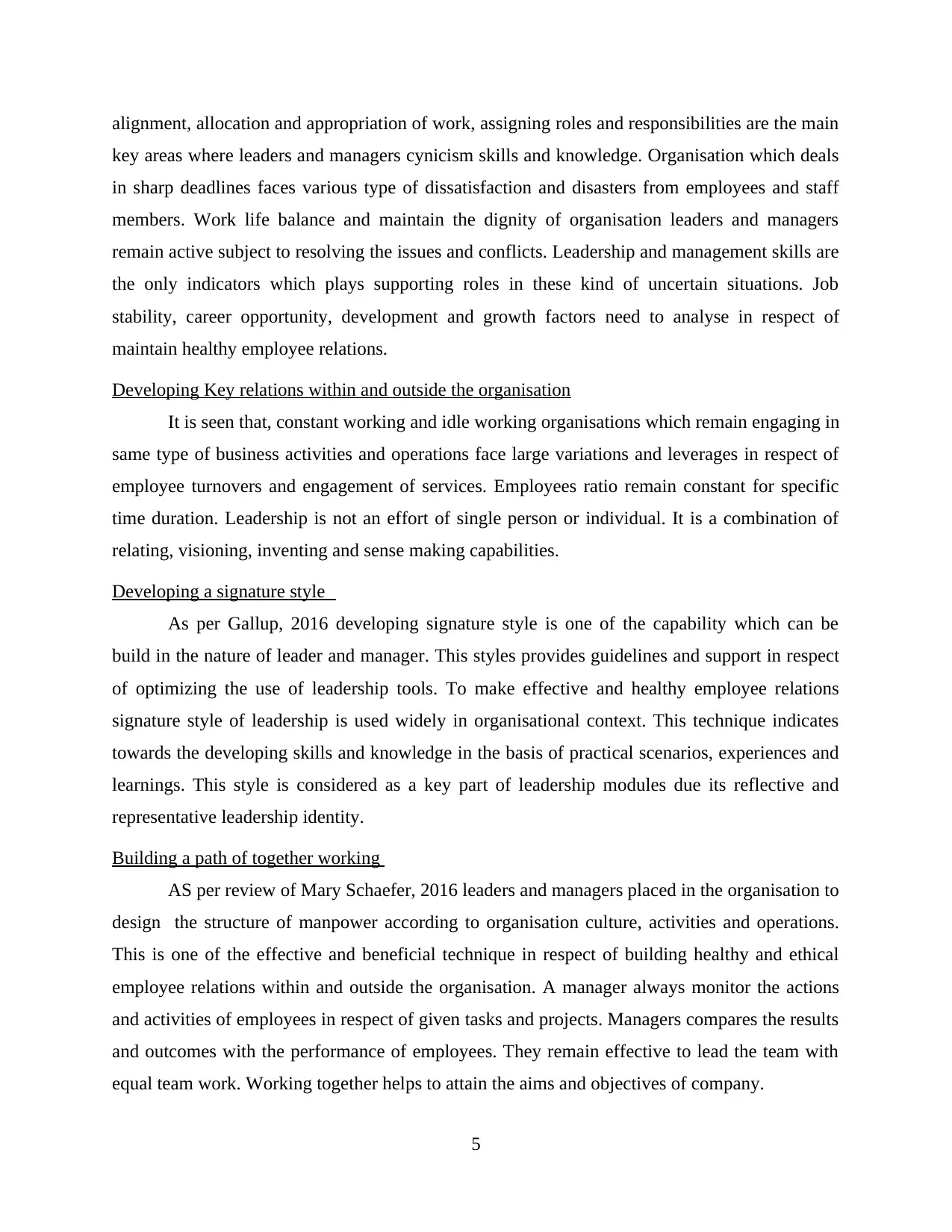
alignment, allocation and appropriation of work, assigning roles and responsibilities are the main
key areas where leaders and managers cynicism skills and knowledge. Organisation which deals
in sharp deadlines faces various type of dissatisfaction and disasters from employees and staff
members. Work life balance and maintain the dignity of organisation leaders and managers
remain active subject to resolving the issues and conflicts. Leadership and management skills are
the only indicators which plays supporting roles in these kind of uncertain situations. Job
stability, career opportunity, development and growth factors need to analyse in respect of
maintain healthy employee relations.
Developing Key relations within and outside the organisation
It is seen that, constant working and idle working organisations which remain engaging in
same type of business activities and operations face large variations and leverages in respect of
employee turnovers and engagement of services. Employees ratio remain constant for specific
time duration. Leadership is not an effort of single person or individual. It is a combination of
relating, visioning, inventing and sense making capabilities.
Developing a signature style
As per Gallup, 2016 developing signature style is one of the capability which can be
build in the nature of leader and manager. This styles provides guidelines and support in respect
of optimizing the use of leadership tools. To make effective and healthy employee relations
signature style of leadership is used widely in organisational context. This technique indicates
towards the developing skills and knowledge in the basis of practical scenarios, experiences and
learnings. This style is considered as a key part of leadership modules due its reflective and
representative leadership identity.
Building a path of together working
AS per review of Mary Schaefer, 2016 leaders and managers placed in the organisation to
design the structure of manpower according to organisation culture, activities and operations.
This is one of the effective and beneficial technique in respect of building healthy and ethical
employee relations within and outside the organisation. A manager always monitor the actions
and activities of employees in respect of given tasks and projects. Managers compares the results
and outcomes with the performance of employees. They remain effective to lead the team with
equal team work. Working together helps to attain the aims and objectives of company.
5
key areas where leaders and managers cynicism skills and knowledge. Organisation which deals
in sharp deadlines faces various type of dissatisfaction and disasters from employees and staff
members. Work life balance and maintain the dignity of organisation leaders and managers
remain active subject to resolving the issues and conflicts. Leadership and management skills are
the only indicators which plays supporting roles in these kind of uncertain situations. Job
stability, career opportunity, development and growth factors need to analyse in respect of
maintain healthy employee relations.
Developing Key relations within and outside the organisation
It is seen that, constant working and idle working organisations which remain engaging in
same type of business activities and operations face large variations and leverages in respect of
employee turnovers and engagement of services. Employees ratio remain constant for specific
time duration. Leadership is not an effort of single person or individual. It is a combination of
relating, visioning, inventing and sense making capabilities.
Developing a signature style
As per Gallup, 2016 developing signature style is one of the capability which can be
build in the nature of leader and manager. This styles provides guidelines and support in respect
of optimizing the use of leadership tools. To make effective and healthy employee relations
signature style of leadership is used widely in organisational context. This technique indicates
towards the developing skills and knowledge in the basis of practical scenarios, experiences and
learnings. This style is considered as a key part of leadership modules due its reflective and
representative leadership identity.
Building a path of together working
AS per review of Mary Schaefer, 2016 leaders and managers placed in the organisation to
design the structure of manpower according to organisation culture, activities and operations.
This is one of the effective and beneficial technique in respect of building healthy and ethical
employee relations within and outside the organisation. A manager always monitor the actions
and activities of employees in respect of given tasks and projects. Managers compares the results
and outcomes with the performance of employees. They remain effective to lead the team with
equal team work. Working together helps to attain the aims and objectives of company.
5
Paraphrase This Document
Need a fresh take? Get an instant paraphrase of this document with our AI Paraphraser
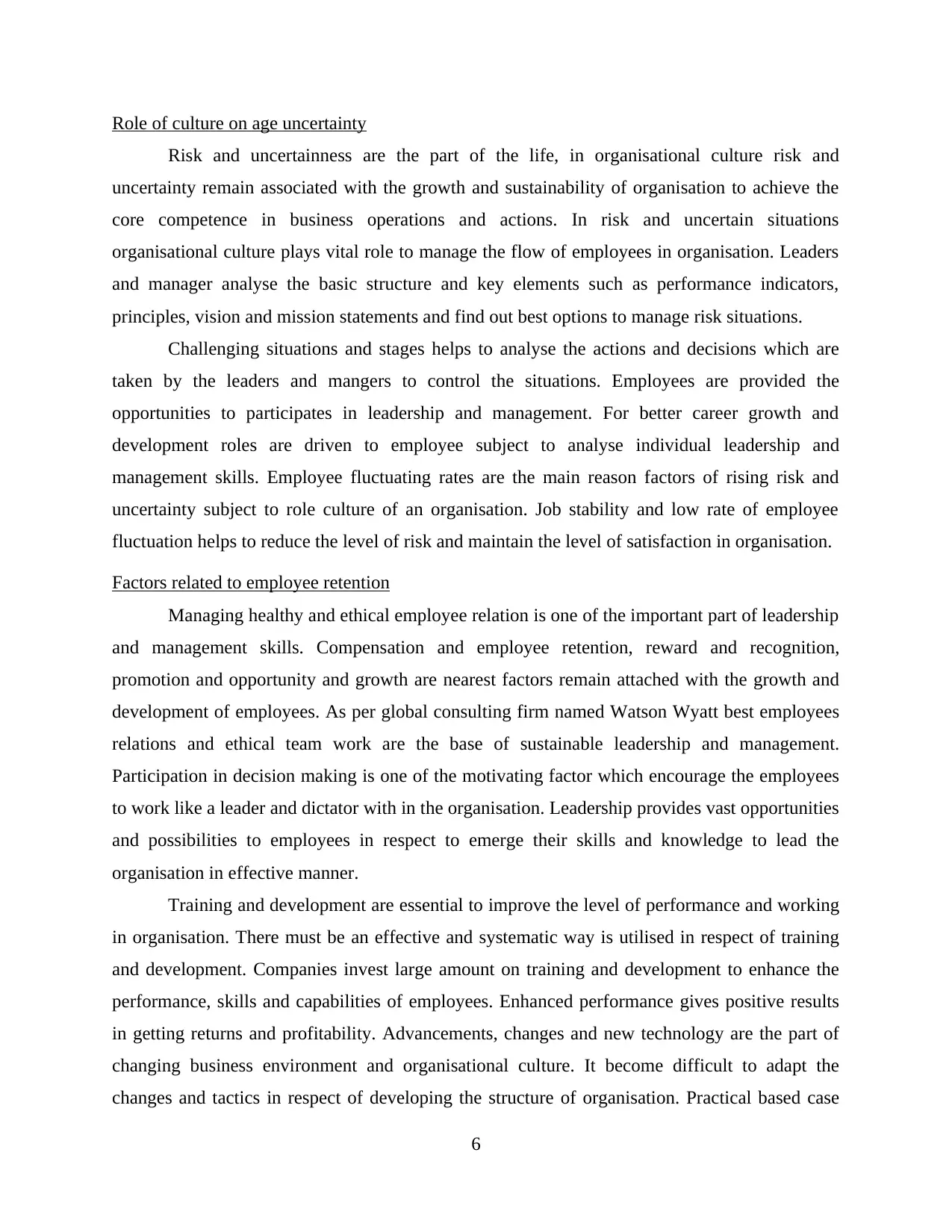
Role of culture on age uncertainty
Risk and uncertainness are the part of the life, in organisational culture risk and
uncertainty remain associated with the growth and sustainability of organisation to achieve the
core competence in business operations and actions. In risk and uncertain situations
organisational culture plays vital role to manage the flow of employees in organisation. Leaders
and manager analyse the basic structure and key elements such as performance indicators,
principles, vision and mission statements and find out best options to manage risk situations.
Challenging situations and stages helps to analyse the actions and decisions which are
taken by the leaders and mangers to control the situations. Employees are provided the
opportunities to participates in leadership and management. For better career growth and
development roles are driven to employee subject to analyse individual leadership and
management skills. Employee fluctuating rates are the main reason factors of rising risk and
uncertainty subject to role culture of an organisation. Job stability and low rate of employee
fluctuation helps to reduce the level of risk and maintain the level of satisfaction in organisation.
Factors related to employee retention
Managing healthy and ethical employee relation is one of the important part of leadership
and management skills. Compensation and employee retention, reward and recognition,
promotion and opportunity and growth are nearest factors remain attached with the growth and
development of employees. As per global consulting firm named Watson Wyatt best employees
relations and ethical team work are the base of sustainable leadership and management.
Participation in decision making is one of the motivating factor which encourage the employees
to work like a leader and dictator with in the organisation. Leadership provides vast opportunities
and possibilities to employees in respect to emerge their skills and knowledge to lead the
organisation in effective manner.
Training and development are essential to improve the level of performance and working
in organisation. There must be an effective and systematic way is utilised in respect of training
and development. Companies invest large amount on training and development to enhance the
performance, skills and capabilities of employees. Enhanced performance gives positive results
in getting returns and profitability. Advancements, changes and new technology are the part of
changing business environment and organisational culture. It become difficult to adapt the
changes and tactics in respect of developing the structure of organisation. Practical based case
6
Risk and uncertainness are the part of the life, in organisational culture risk and
uncertainty remain associated with the growth and sustainability of organisation to achieve the
core competence in business operations and actions. In risk and uncertain situations
organisational culture plays vital role to manage the flow of employees in organisation. Leaders
and manager analyse the basic structure and key elements such as performance indicators,
principles, vision and mission statements and find out best options to manage risk situations.
Challenging situations and stages helps to analyse the actions and decisions which are
taken by the leaders and mangers to control the situations. Employees are provided the
opportunities to participates in leadership and management. For better career growth and
development roles are driven to employee subject to analyse individual leadership and
management skills. Employee fluctuating rates are the main reason factors of rising risk and
uncertainty subject to role culture of an organisation. Job stability and low rate of employee
fluctuation helps to reduce the level of risk and maintain the level of satisfaction in organisation.
Factors related to employee retention
Managing healthy and ethical employee relation is one of the important part of leadership
and management skills. Compensation and employee retention, reward and recognition,
promotion and opportunity and growth are nearest factors remain attached with the growth and
development of employees. As per global consulting firm named Watson Wyatt best employees
relations and ethical team work are the base of sustainable leadership and management.
Participation in decision making is one of the motivating factor which encourage the employees
to work like a leader and dictator with in the organisation. Leadership provides vast opportunities
and possibilities to employees in respect to emerge their skills and knowledge to lead the
organisation in effective manner.
Training and development are essential to improve the level of performance and working
in organisation. There must be an effective and systematic way is utilised in respect of training
and development. Companies invest large amount on training and development to enhance the
performance, skills and capabilities of employees. Enhanced performance gives positive results
in getting returns and profitability. Advancements, changes and new technology are the part of
changing business environment and organisational culture. It become difficult to adapt the
changes and tactics in respect of developing the structure of organisation. Practical based case
6
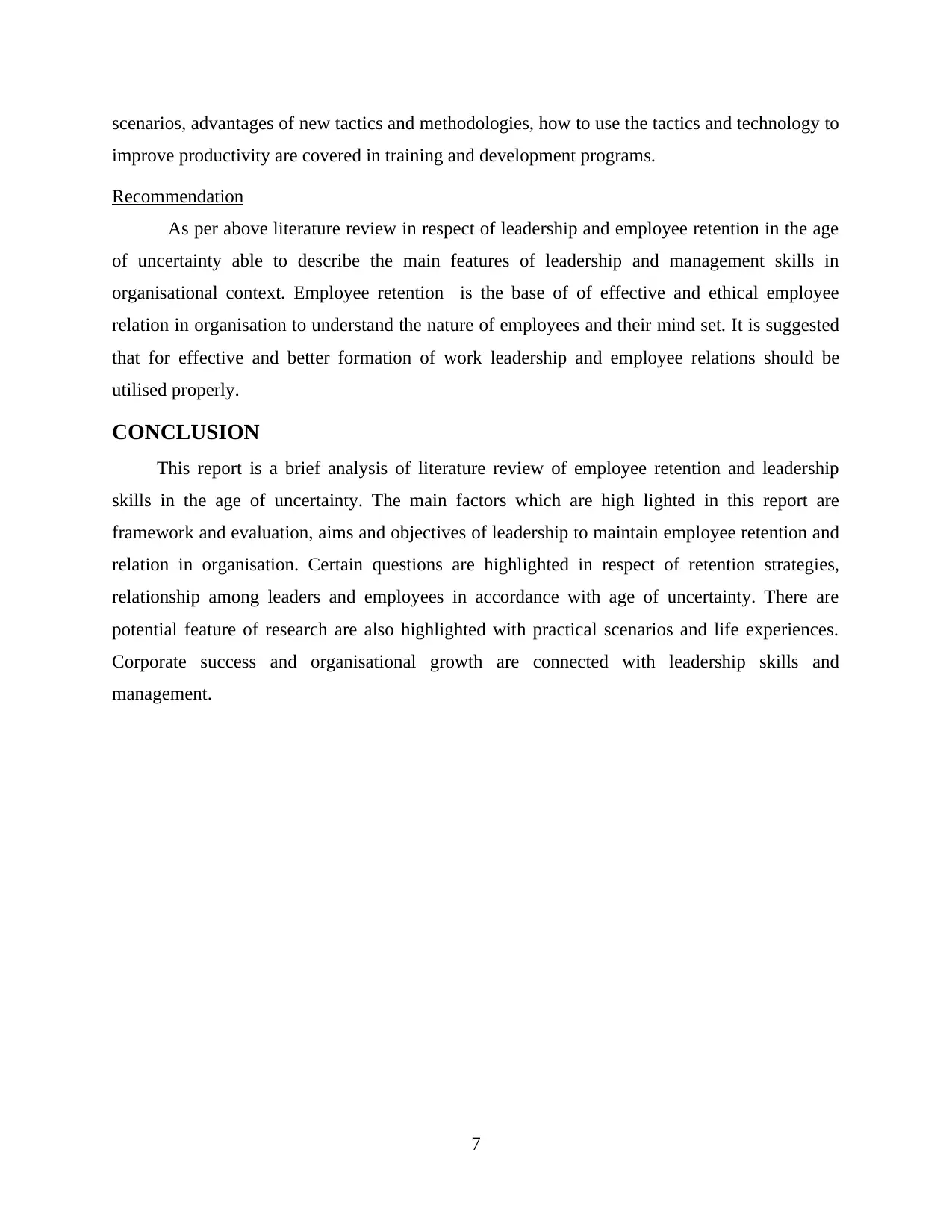
scenarios, advantages of new tactics and methodologies, how to use the tactics and technology to
improve productivity are covered in training and development programs.
Recommendation
As per above literature review in respect of leadership and employee retention in the age
of uncertainty able to describe the main features of leadership and management skills in
organisational context. Employee retention is the base of of effective and ethical employee
relation in organisation to understand the nature of employees and their mind set. It is suggested
that for effective and better formation of work leadership and employee relations should be
utilised properly.
CONCLUSION
This report is a brief analysis of literature review of employee retention and leadership
skills in the age of uncertainty. The main factors which are high lighted in this report are
framework and evaluation, aims and objectives of leadership to maintain employee retention and
relation in organisation. Certain questions are highlighted in respect of retention strategies,
relationship among leaders and employees in accordance with age of uncertainty. There are
potential feature of research are also highlighted with practical scenarios and life experiences.
Corporate success and organisational growth are connected with leadership skills and
management.
7
improve productivity are covered in training and development programs.
Recommendation
As per above literature review in respect of leadership and employee retention in the age
of uncertainty able to describe the main features of leadership and management skills in
organisational context. Employee retention is the base of of effective and ethical employee
relation in organisation to understand the nature of employees and their mind set. It is suggested
that for effective and better formation of work leadership and employee relations should be
utilised properly.
CONCLUSION
This report is a brief analysis of literature review of employee retention and leadership
skills in the age of uncertainty. The main factors which are high lighted in this report are
framework and evaluation, aims and objectives of leadership to maintain employee retention and
relation in organisation. Certain questions are highlighted in respect of retention strategies,
relationship among leaders and employees in accordance with age of uncertainty. There are
potential feature of research are also highlighted with practical scenarios and life experiences.
Corporate success and organisational growth are connected with leadership skills and
management.
7
⊘ This is a preview!⊘
Do you want full access?
Subscribe today to unlock all pages.

Trusted by 1+ million students worldwide
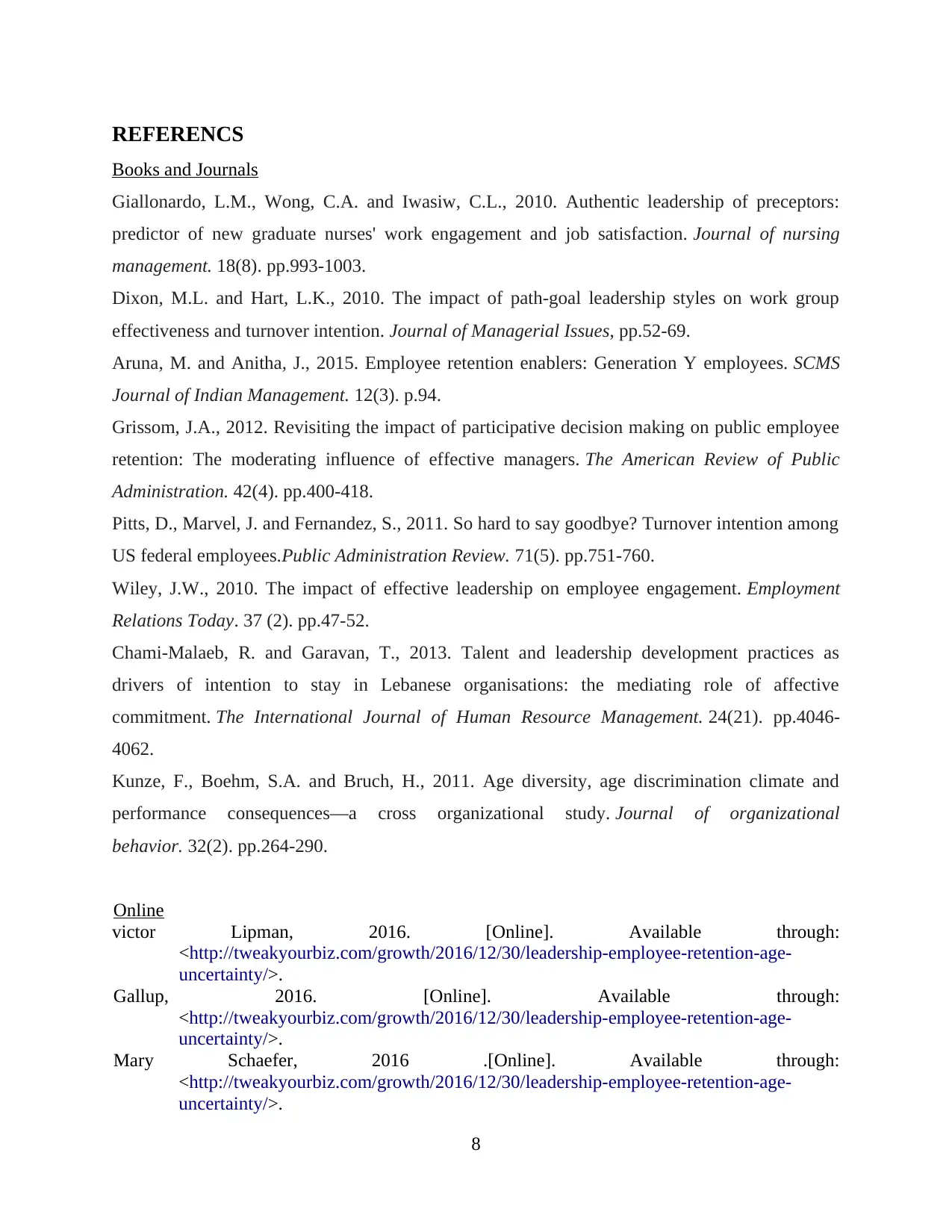
REFERENCS
Books and Journals
Giallonardo, L.M., Wong, C.A. and Iwasiw, C.L., 2010. Authentic leadership of preceptors:
predictor of new graduate nurses' work engagement and job satisfaction. Journal of nursing
management. 18(8). pp.993-1003.
Dixon, M.L. and Hart, L.K., 2010. The impact of path-goal leadership styles on work group
effectiveness and turnover intention. Journal of Managerial Issues, pp.52-69.
Aruna, M. and Anitha, J., 2015. Employee retention enablers: Generation Y employees. SCMS
Journal of Indian Management. 12(3). p.94.
Grissom, J.A., 2012. Revisiting the impact of participative decision making on public employee
retention: The moderating influence of effective managers. The American Review of Public
Administration. 42(4). pp.400-418.
Pitts, D., Marvel, J. and Fernandez, S., 2011. So hard to say goodbye? Turnover intention among
US federal employees.Public Administration Review. 71(5). pp.751-760.
Wiley, J.W., 2010. The impact of effective leadership on employee engagement. Employment
Relations Today. 37 (2). pp.47-52.
Chami-Malaeb, R. and Garavan, T., 2013. Talent and leadership development practices as
drivers of intention to stay in Lebanese organisations: the mediating role of affective
commitment. The International Journal of Human Resource Management. 24(21). pp.4046-
4062.
Kunze, F., Boehm, S.A. and Bruch, H., 2011. Age diversity, age discrimination climate and
performance consequences—a cross organizational study. Journal of organizational
behavior. 32(2). pp.264-290.
Online
victor Lipman, 2016. [Online]. Available through:
<http://tweakyourbiz.com/growth/2016/12/30/leadership-employee-retention-age-
uncertainty/>.
Gallup, 2016. [Online]. Available through:
<http://tweakyourbiz.com/growth/2016/12/30/leadership-employee-retention-age-
uncertainty/>.
Mary Schaefer, 2016 .[Online]. Available through:
<http://tweakyourbiz.com/growth/2016/12/30/leadership-employee-retention-age-
uncertainty/>.
8
Books and Journals
Giallonardo, L.M., Wong, C.A. and Iwasiw, C.L., 2010. Authentic leadership of preceptors:
predictor of new graduate nurses' work engagement and job satisfaction. Journal of nursing
management. 18(8). pp.993-1003.
Dixon, M.L. and Hart, L.K., 2010. The impact of path-goal leadership styles on work group
effectiveness and turnover intention. Journal of Managerial Issues, pp.52-69.
Aruna, M. and Anitha, J., 2015. Employee retention enablers: Generation Y employees. SCMS
Journal of Indian Management. 12(3). p.94.
Grissom, J.A., 2012. Revisiting the impact of participative decision making on public employee
retention: The moderating influence of effective managers. The American Review of Public
Administration. 42(4). pp.400-418.
Pitts, D., Marvel, J. and Fernandez, S., 2011. So hard to say goodbye? Turnover intention among
US federal employees.Public Administration Review. 71(5). pp.751-760.
Wiley, J.W., 2010. The impact of effective leadership on employee engagement. Employment
Relations Today. 37 (2). pp.47-52.
Chami-Malaeb, R. and Garavan, T., 2013. Talent and leadership development practices as
drivers of intention to stay in Lebanese organisations: the mediating role of affective
commitment. The International Journal of Human Resource Management. 24(21). pp.4046-
4062.
Kunze, F., Boehm, S.A. and Bruch, H., 2011. Age diversity, age discrimination climate and
performance consequences—a cross organizational study. Journal of organizational
behavior. 32(2). pp.264-290.
Online
victor Lipman, 2016. [Online]. Available through:
<http://tweakyourbiz.com/growth/2016/12/30/leadership-employee-retention-age-
uncertainty/>.
Gallup, 2016. [Online]. Available through:
<http://tweakyourbiz.com/growth/2016/12/30/leadership-employee-retention-age-
uncertainty/>.
Mary Schaefer, 2016 .[Online]. Available through:
<http://tweakyourbiz.com/growth/2016/12/30/leadership-employee-retention-age-
uncertainty/>.
8
1 out of 10
Related Documents
Your All-in-One AI-Powered Toolkit for Academic Success.
+13062052269
info@desklib.com
Available 24*7 on WhatsApp / Email
![[object Object]](/_next/static/media/star-bottom.7253800d.svg)
Unlock your academic potential
Copyright © 2020–2025 A2Z Services. All Rights Reserved. Developed and managed by ZUCOL.





